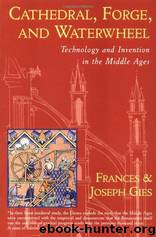Cathedral, Forge, and Waterwheel: Technology and Invention in the Middle Ages by Gies Joseph

Author:Gies, Joseph [Gies, Joseph]
Language: eng
Format: epub
Tags: History
ISBN: 9780060925819
Barnesnoble:
Goodreads: 33057
Publisher: Harper Perennial
Published: 1994-01-01T00:00:00+00:00
The Medieval City
In the prosperous thirteenth century, European cities began for the first time to rival in size and importance those of the classical world and contemporary Asia. Paris, London, Ghent, Bruges, Cologne, Florence, Genoa, Pisa, and others now sheltered behind their battlemented walls large and growing populations of craftsmen and merchants living lives free from feudal subjection, if not from modern tax oppression. It has been calculated that in 1380 half the population of Flanders and neighboring Brabant dwelt in cities.
In contrast with that of a late Roman or early medieval administrative center, the life of a thirteenth-century commercial and industrial city was full of activity: craftsmen working, merchants trafficking, wagons creaking, all the noise, bustle, and vitality of urban life. Its consumption was satisfied by a busy transport system, its exports and imports were underwritten by sophisticated credit arrangements, its many needs so successfully satisfied that one modern historian asserts that “few significant refinements were added” until recent times.58
That is not to say that no further “refinements” were needed. The high population density was met in part by houses sharing party walls and subdivided into small apartments.59 Inevitably, problems of waste disposal and pollution arose. Tanners and butchers discarded entrails, blood, and hair in the streets; animals dropped manure; pigs, dogs, and rats raided garbage; open ditches served as sewers for storm water and wastewater; privies and cesspits occupied backyards. Traffic—horse, cart, pedestrian, and animal—crowded the streets, piling up at the gates where tolls were collected. Collisions provoked a stream of lawsuits.60 Heating and cooking, as well as industry, added smoke to the atmosphere. The smoke was almost entirely from wood and charcoal, whose fires had two other drawbacks: in combination with timber framing and thatched roofs, they created a citywide fire hazard, and they depleted the neighboring forest. Charcoal was especially wasteful of medieval man’s best resource; while it gave more heat, essential in most industrial processes, its preparation burned up several times its weight in wood. Yet even where superior heating capacity was not needed, charcoal was often used because its lightness made it more transportable. Home heating was in any case extremely inefficient owing to the lack of window glass or insulation.61
Coal was known in Europe at least by the thirteenth century but was sparingly used out of fear of the toxic nature of its fumes. In England it was first gathered from outcroppings washed ashore on the northeast coast and was known as “sea coal,” a name that stuck even later when it was mined inland.62
Download
This site does not store any files on its server. We only index and link to content provided by other sites. Please contact the content providers to delete copyright contents if any and email us, we'll remove relevant links or contents immediately.
Learning SQL by Alan Beaulieu(6237)
Weapons of Math Destruction by Cathy O'Neil(6219)
Digital Minimalism by Cal Newport;(5704)
iGen by Jean M. Twenge(5386)
Sapiens by Yuval Noah Harari(5325)
The Age of Surveillance Capitalism by Shoshana Zuboff(4248)
Elon Musk by Ashlee Vance(4084)
Thing Explainer by Randall Munroe(3910)
Apollo 8 by Jeffrey Kluger(3668)
Future Crimes by Marc Goodman(3565)
The Science Book (Big Ideas Simply Explained) by DK(3254)
Who Can You Trust? by Rachel Botsman(3111)
The Innovators: How a Group of Hackers, Geniuses, and Geeks Created the Digital Revolution by Walter Isaacson(2997)
I Live in the Future & Here's How It Works by Nick Bilton(2961)
Infinite Energy Technologies by Finley Eversole(2953)
Steve Jobs by Walter Isaacson(2858)
Dawn of the New Everything by Jaron Lanier(2751)
Chernobyl by Serhii Plokhy(2515)
Ben Franklin's Almanac by Candace Fleming(2492)
